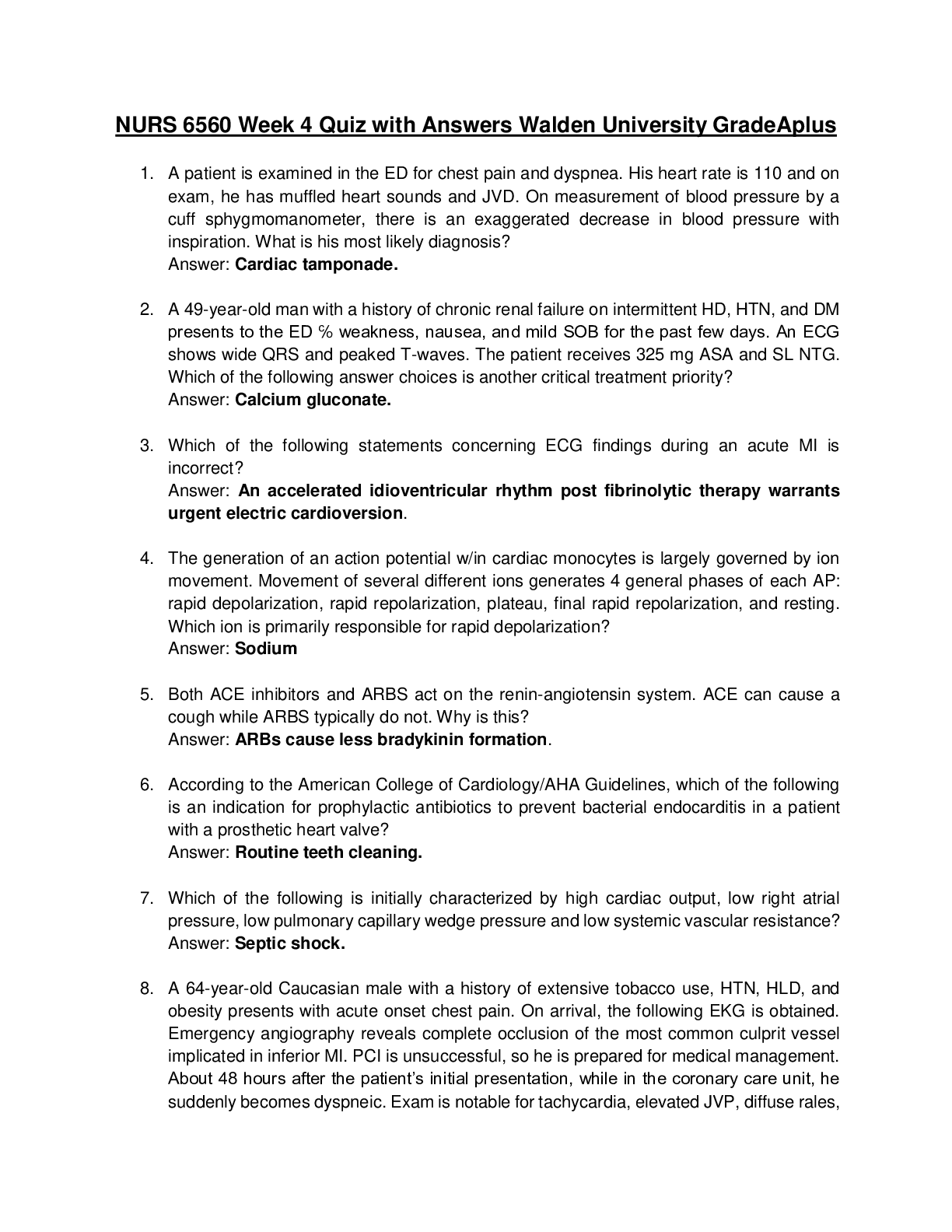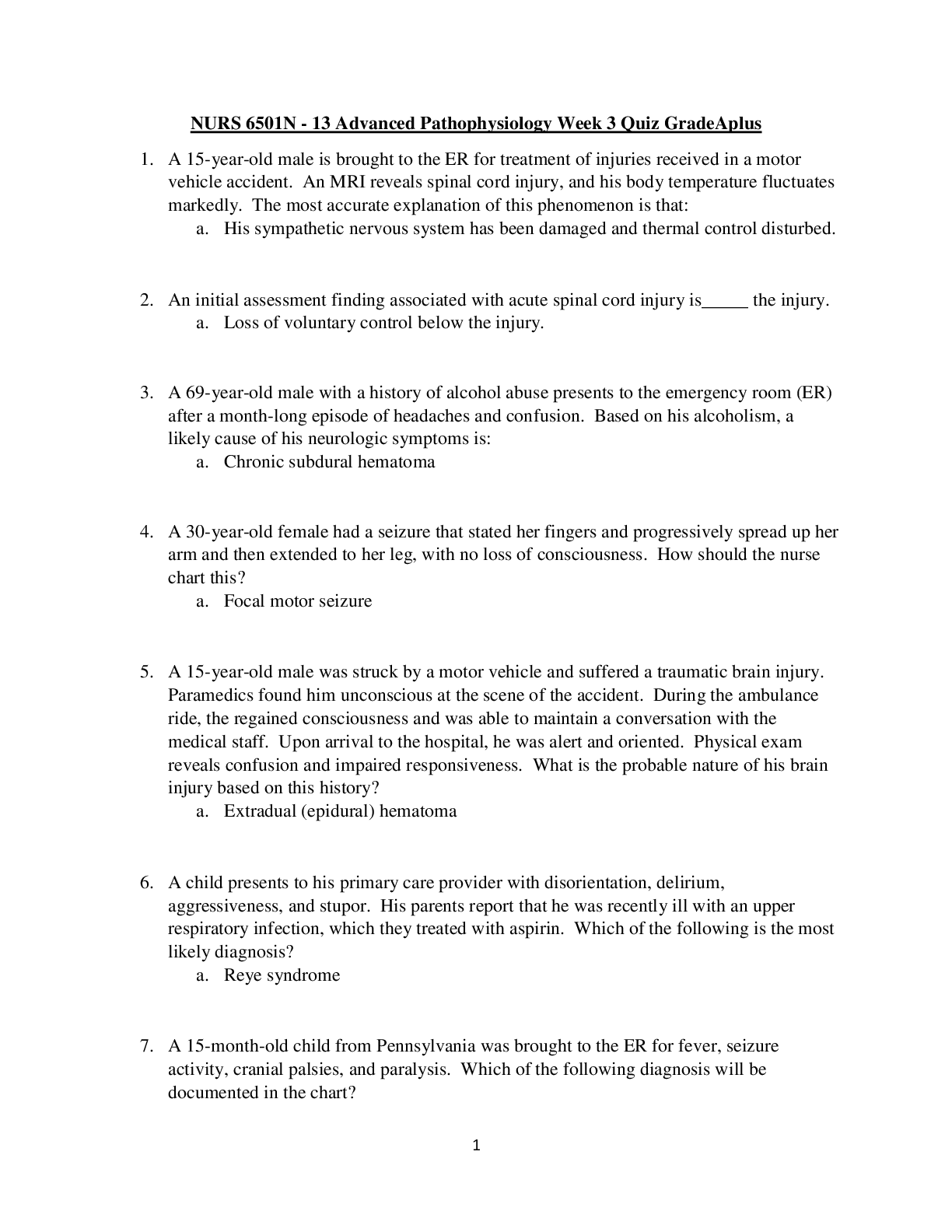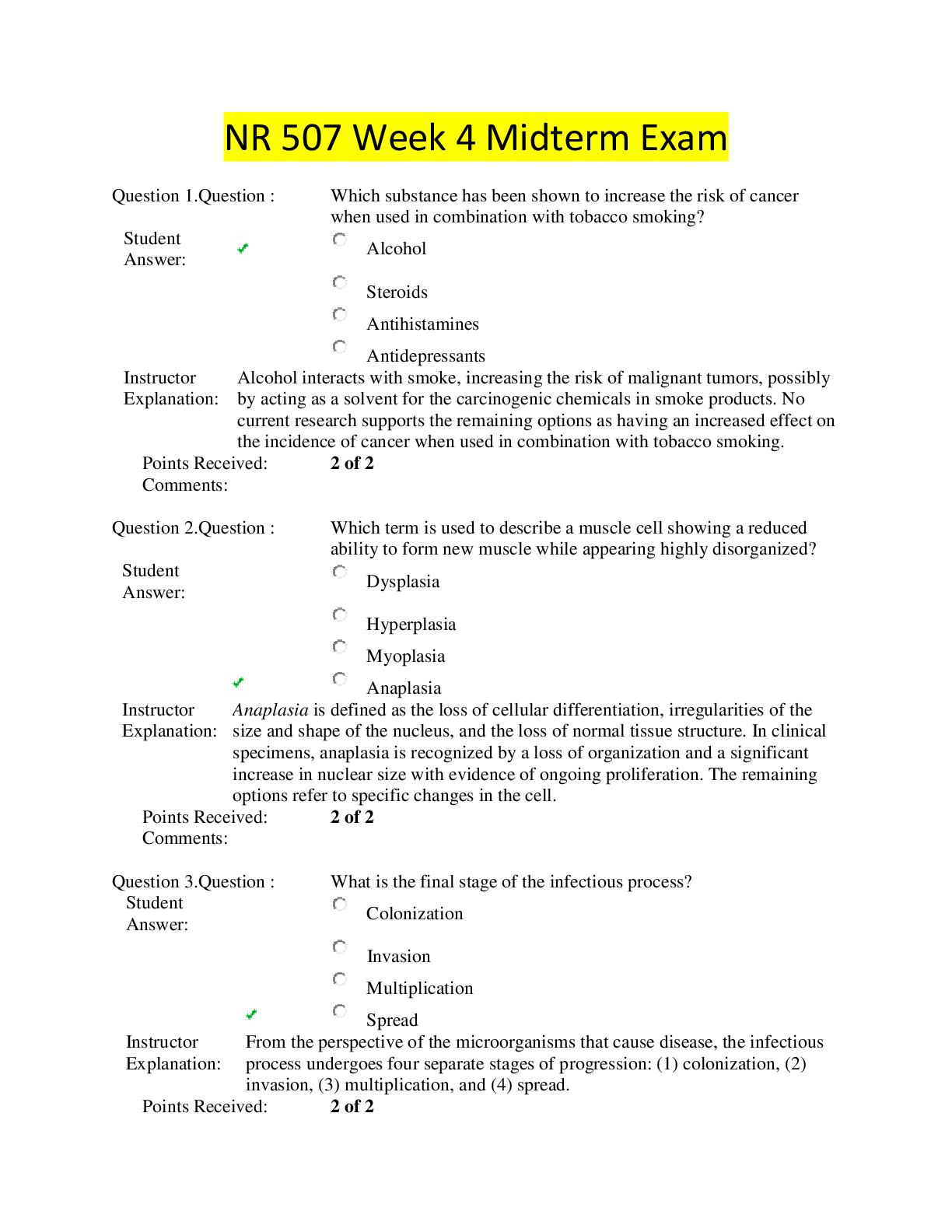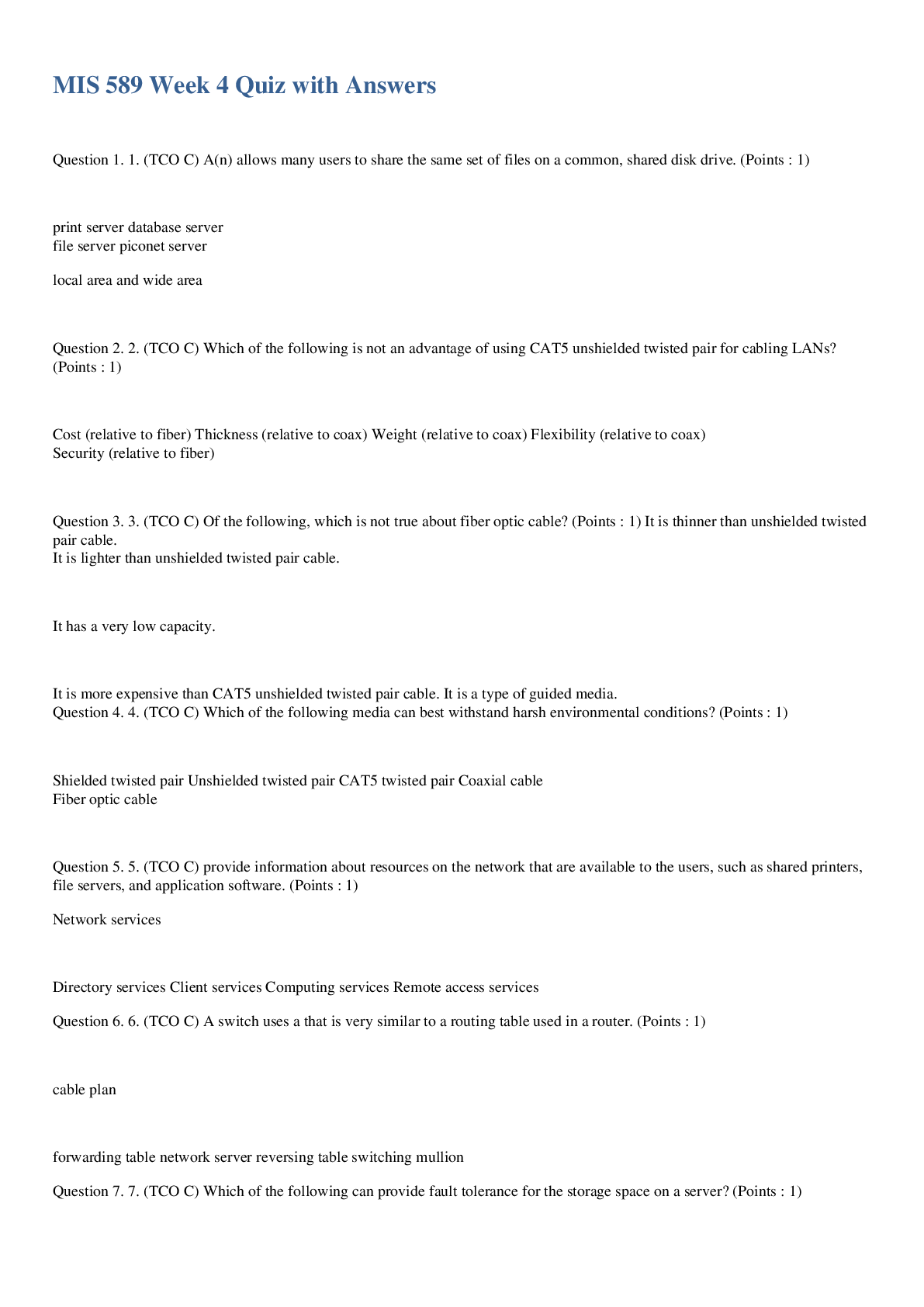NURS 6501N Advanced Pathophysiology Week 4 Quiz with Answer GradeAplus
Document Content and Description Below
1. An 80-year-old female is in the hospital for a bone fracture. While there she develops a large, nonlethal pulmonary embolus. Which of the following is a direct result of the obstruction to pulmon... ary blood flow? 2. A 62-year-old male presents to his primary care provider reporting chest pain at rest and with exertion. He does not have a history of coronary artery disease and reports that the pain often occurs at night. He is most likely experiencing which type of angina? 3. A 65-year-old male presents for a routine checkup. A blood pressure check reveals a systolic pressure of 160 mm Hg and a diastolic pressure of 70 mm Hg. Which of the following is the most likely cause of this type of pressure elevation? 4. A 70-year-old female is in the hospital for pelvic fracture. She develops pulmonary thromboembolism. The nurse realizes this embolus is composed of: 5. A 60-year-old male is diagnosed with cerebral aneurysm. Where does the nurse suspect the cerebral aneurysm is located? 6. When a patient has a massive pulmonary embolism (PE), what complications will the nurse monitor for? 7. Which of the following patients is at highest risk for developing pulmonary embolism (PE)? 8. A 30-year-old Caucasian female was recently diagnosed with primary hypertension. She reports that she eats fairly well, usually having red meat and potatoes daily. She also reports that her father has hypertension as well. A nurse determines which of the following risk factors is most likely associated with his diagnosis? 9. A 65-year-old male is transported to the ER for chest pain. An electrocardiogram reveals a prolonged QRS interval. What is the nurse monitoring when the nurse observes the QRS complex on the electrocardiogram? The QRS complex reflects: 10. A 52-year-old female is diagnosed with coronary artery disease. The nurse assesses for myocardial: 11. A 35-year-old male presents with pulmonary hypertension. Testing reveals he is in right heart failure. Which of the following is the most likely diagnosis the nurse will see listed on the chart? 12. A 50-year-old female presents with a low heart rate and low blood pressure. She is given an intravenous (IV) infusion of fluids. The increase in atrial distention results in: 13. A 56-year-old male is diagnosed with coronary artery disease. Which of the following modifiable risk factors would the nurse suggest the patient change? 14. A 50-year-old obese male with hypertension and coronary artery disease visits a nutritionist for food counseling. He has an elevated level of low-density lipoprotein (LDL) and a low level of high-density lipoprotein (HDL). Which of the following should the nurse advise him to avoid? 15. Which condition should cause the nurse to assess for high-output failure in a patient? 16. A 28-year-old female presents with severe chest pain and shortness of breath. She is diagnosed with pulmonary embolism, which most likely originated from the: 17. A 65-year-old female presents to the emergency department reporting difficulty swallowing and shortness of breath. A CT scan would most likely reveal an aneurysm in the: 18. A 59-year-old female is diagnosed with left ventricle failure. If a decrease in kidney perfusion occurs, the nurse knows this would ultimately cause: 19. A 65-year-old male is diagnosed with chronic pulmonary disease and elevated pulmonary vascular resistance. Which of the following heart failures should the nurse asses for in this patient? 20. An 82-year-old female was admitted to the hospital with confusion and severe hypotension. Her body’s compensatory mechanisms are increased heart rate, vasoconstriction, and movement of large volumes of interstitial fluid to the vascular compartment. What kind of shock does the nurse suspect the patient is experiencing? 21. A 75-year-old female has been critically ill with multiple organ dysfunction syndrome (MODS) for longer than a week and has developed a severe oxygen supply and demand imbalance. The statement that best describes this imbalance is which of the following? 22. What term should the nurse document for a detached blood clot? 23. Which organ should the nurse monitor closely since it is often the first to fail in patients with multiple organ dysfunction syndrome (MODS)? 24. A 50-year-old male visits the cardiologist for an EKG. Results indicate that he has no PR interval and a variable QRS rate with rhythm irregularity. Which of the following is the most likely diagnosis to be recorded in the chart? 25. A 52-year-old male is diagnosed with primary hypertension. He has no other health problems. Present treatment would cause the nurse to anticipate administrating which drug to the patient? 26. A 50-year-old female received trauma to the chest that caused severe impairment of the primary pacemaker cells of the heart. Which of the following areas received the greatest damage? 27. A 60-year-old male undergoes surgery for a bone fracture. Which of the following nursing measures would be most effective for preventing pulmonary embolism (PE) in this patient? 28. A 50-year-old male with a 30-year history of smoking was diagnosed with bronchogenic cancer. He developed edema and venous distention in the upper extremities and face. Which of the following diagnosis will the nurse observe on the chart? 29. A 54-year-old male is diagnosed with left bundle branch block. Which of the following structures would not receive an electrical impulse? 30. When a nurse checks the patient for orthostatic hypotension, what did the nurse have the patient do? [Show More]
Last updated: 2 years ago
Preview 1 out of 4 pages
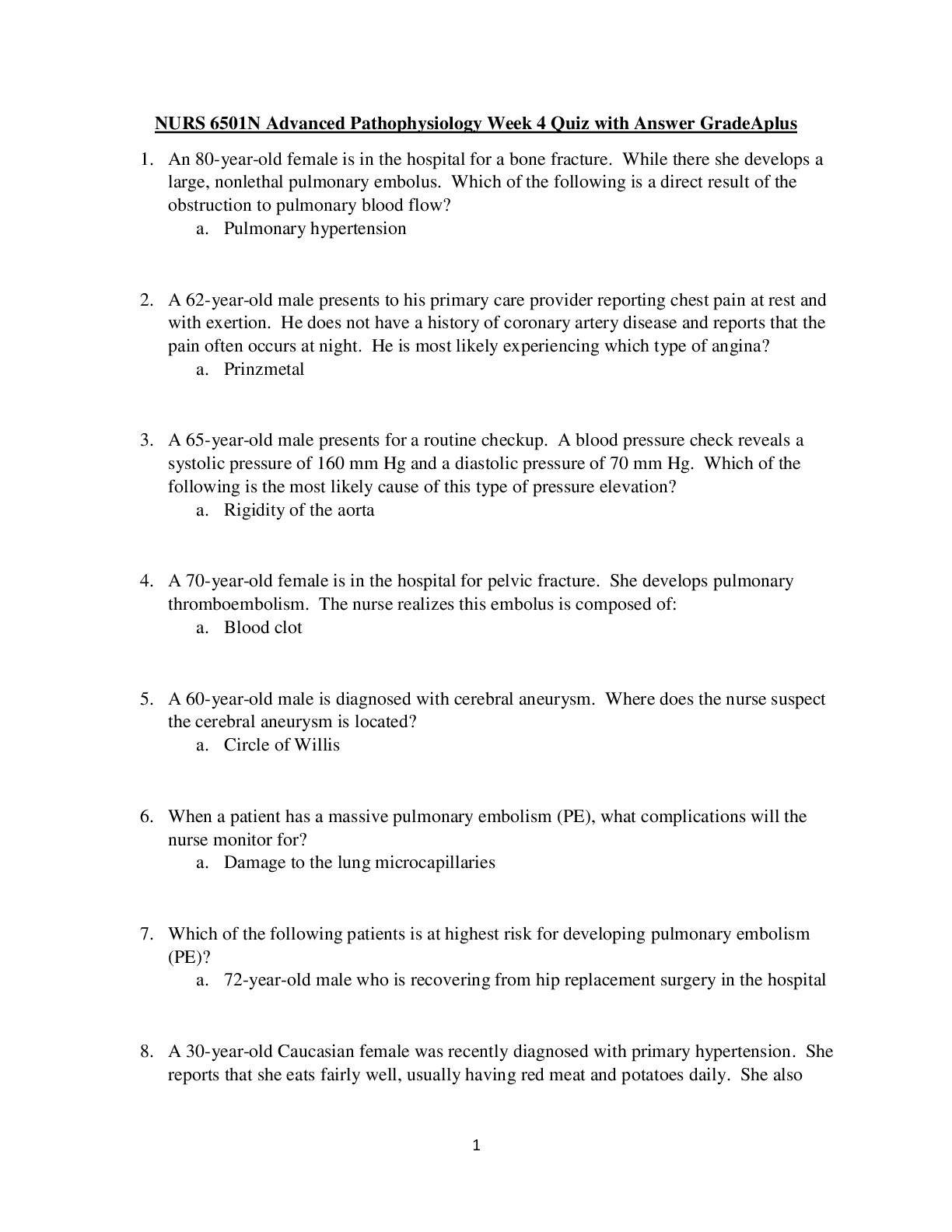
Buy this document to get the full access instantly
Instant Download Access after purchase
Buy NowInstant download
We Accept:

Reviews( 0 )
$10.00
Can't find what you want? Try our AI powered Search
Document information
Connected school, study & course
About the document
Uploaded On
Mar 06, 2020
Number of pages
4
Written in
Additional information
This document has been written for:
Uploaded
Mar 06, 2020
Downloads
0
Views
83














